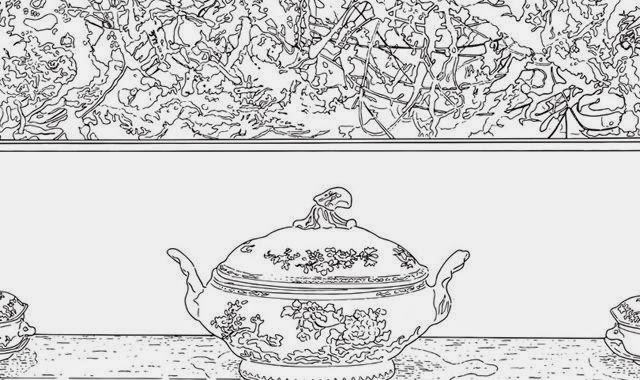What is interesting about this is how attuned we are
to different types of tracing. In this case a specialist children’s book
illustrator was brought in to make the tracings and therefore these ‘tracings’
are rendered in such a way that they resemble children’s colouring book pages.
Lawler obviously realised that tracing is a serious business and that the key
is in selection. The children’s book illustrator is obviously skilled and
understands what makes for a clear read. Another person doing the tracing might
select totally different areas, ones that are not so iconic or clear. I presume
the final illustrations were rendered in ‘Illustrator’ especially as they were
finally rendered as stick-on vinyl wall pieces and ‘Illustrator’ files are
usually the norm for this type of work. This of course gives the work another
connotation, that of commercial signage.
Lawler’s best known work is a critique of the art
world and points out that once a Jackson Pollock is hung alongside other
‘objects d’art’ in a rich collector’s home, both objects change status and use
value and become part of a series of very specialised information and value exchanges.
By tracing her own work, Lawler points out how her photographic critique itself is now
becoming part of the established art world norm. The simplicity of its
rendering, reminding us all of the simplicity of art world values.
One issue about vinyl wall transfers is that they are a
way of making a drawing an extension of the architecture within which it is placed. In this case, because the drawings are now an integral part of the gallery walls, Lawler is adding the gallery to the ‘art world’,
just as the work itself is subsumed into this. On the other hand it is worth
remembering that using vinyls in this way is a reasonably cheap way of getting
a very professional surface and clean cut image, produced on an architectural
scale. Any of you thinking about how to work directly on walls or even glass
surfaces might think about investing in this type of image production.
Louise Lawler's "Pollock and Tureen (traced)," 1984/2013
See also:
The Bézier Curve Thoughts on the maths behind drawing software programs such as 'Illustrator'
Painting by numbers A children's book illustrator is used to sort out and clarify the flat forms used for this process
